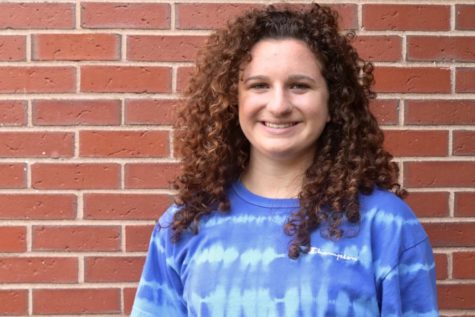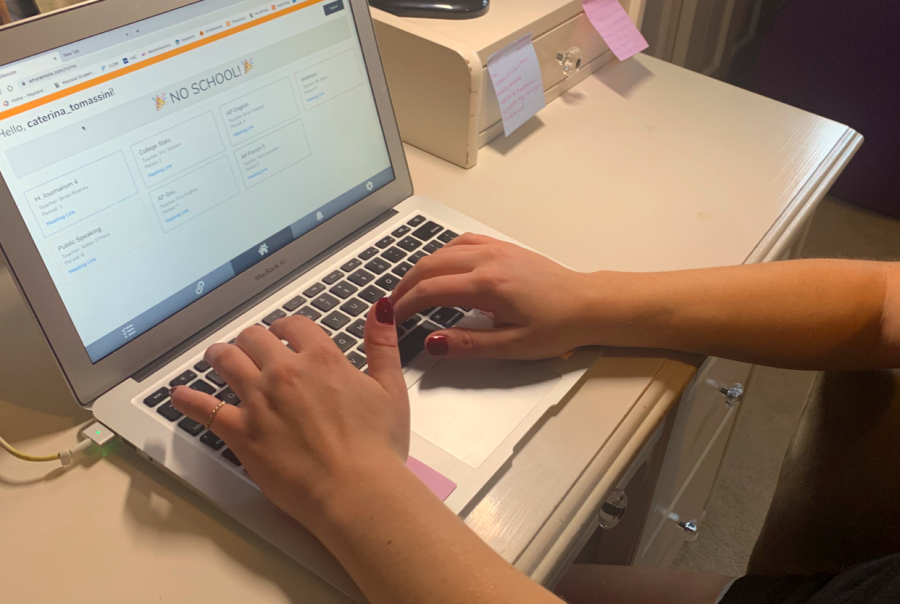Students experience mixed reactions to the first weeks of remote learning
Credit: Caterina Tomassini
With remote learning approaching its third week at WHS, students are beginning to navigate a new way of learning. Some students are adjusting well while others are struggling to adapt, so WSPN’s Atharva Weling and Caterina Tomassini sit down with students to discuss the pros and cons of online school. “Everything’s online, so it’s easy to sit down with my computer and get all of my work done,” senior Luca Norian said. “I don’t need to take out a bunch of worksheets, so it’s very easy to get everything done in one session.”
With the coronavirus pandemic continuing to pose a serious risk to public health, on Aug. 31, Wayland High School Principal Allyson Mizoguchi announced the school board’s plan to start the year under a remote learning model, with the plan to switch to a hybrid model in mid-October if health conditions are favorable. Now that the first few weeks of school has ended, students have developed a variety of opinions regarding how effective online instruction has been and what effect it has had on their physical and mental health.
After last spring’s hastily put-together online learning strategy, which was a source of concern for students and parents alike, senior Luca Norian was hesitant about starting out remote this year, thinking it would be a disaster.
“I thought remote learning was going to go terribly because the way we finished school last year was so disorganized, and I was unmotivated since it felt like it didn’t even count,” Norian said. “Everything was just for credit.”
However, Norian soon found that this year’s online education would be very different from last year’s. He has greatly enjoyed the experience, especially because of all the new online learning applications he gets to use.
“[Online learning] forces teachers to update the way they teach, and they are using new tools and websites that I’ve never seen before but love,” he said.
For freshman Juliana Perdomo-Barrios, last spring’s remote learning experiences were encouraging, and those, combined with her independence, has made the remote model fairly easy to manage.
“Since we already had a couple of months on remote learning [last year], I think it was just easier to adapt especially since this year it’s nothing new,” Perdomo-Barrios said, “I don’t really need extra help or anything, so I can learn pretty quick so I guess that helps as well.”
Senior Sophia Mastrangelo feels similarly, as she feels that the transition to a remote model hasn’t been too demanding despite the changes from last spring.
“It was definitely different because it was a whole new experience,” Mastrangelo said. “But, over time I feel like I’ve adjusted to it. It was slow at first, but I’ve found my way and started to adjust the best I could.”
More important than missing in-person classes, however, has been the effect of the remote model on Perdomo-Barrios’ ability to participate in extracurricular activities. Her volleyball season, which is traditionally in the fall, has been pushed back to February due to the pandemic, and the lack of any information about other activities has made it difficult for her to join remotely.
“A couple [of] high schoolers came to our school and just talked about clubs, but not so much that we knew which ones to do or how to sign up for everything like that,” Perdomo-Barrios said. “So I don’t really know what clubs are available right now.”
While her academic adjustment has been fairly easy, Perdomo-Barrios has shared one obstacle with that other WHS students may have experienced: frequent headaches. Although she has been caring for these headaches with medicine, she still believes that her learning would be much improved, especially in the afternoon, if they weren’t an issue.
While the physical effects of remote learning have been an issue, Perdomo-Barrios has had little in the way of mental health issues. She attributes this to the time management skills she learned in middle school and finds that the remote model helps her get more of her work done the day it’s assigned.
Norian, like Perdomo-Barrios, feels that the remote setting provides new opportunities to be independent. He found that, unlike during a pre-COVID-19 school year, he has more freedom regarding when he has to do his homework. In this schedule, classes don’t meet every day, so Norian does the majority of his homework on Sundays and on Wednesdays, which are meant for student independent work and office hours.
“It’s the feeling of independence that helps me get my work done,” Norian said. “Everything’s online, so it’s easy to sit down with my computer and get all of my work done. I don’t need to take out a bunch of worksheets, so it’s very easy to get everything done in one session.”
While Perdomo-Barrios may not be experiencing mental health problems, a significant portion of WHS students have expressed otherwise. In a WSPN survey of nearly 270 students, 43% say that their mental health has declined under the remote model and 73% say that going back in the hybrid model would cause an improvement. Norian agrees.
“I want to go back because I feel bad for the other people who don’t like online school, but if it were up to me, I wouldn’t go back,” Norian said, “I also don’t feel like I’m learning any less. If anything, I feel like I’m learning more.”
Your donation will support the student journalists of Wayland High School. Your contribution will allow us to purchase equipment, cover our annual website hosting costs and sponsor admission and traveling costs for the annual JEA journalism convention.

Atharva Weling, Class of 2021, is the opinions editor for WSPN in his second year on the staff. He runs cross-country and skis for Wayland and serves as...

Caterina Tomassini, class of 2021, is a fourth year journalism student and is the managing editor this year. Outside of journalism, Tomassini plays club...





![Last Wednesday, the Wayland School Committee gathered to discuss a number of topics regarding the health curriculum and Innovation Career Pathway course. Another large topic of conversation was the ways to potentially mitigate distracting cell phone usage. "These [phones] are going to distract your learning and social relationships," Superintendent David Fleishman said. "That's concrete right there."](https://waylandstudentpress.com/wp-content/uploads/2025/06/Screenshot-2025-06-04-at-9.49.31 PM-1200x886.png)



























![Troy Hoyt finishes the Boston Marathon, running for the Hoyt Foundation. T. Hoyt is the son of Hoyt Foundation CEO Russ Hoyt.
“[Running a marathon] might seem like a big thing, when it’s presented to you at first, but if you break it up and just keep telling yourself, “Yes, you can,” you can start chipping away at it. And before you know it, you’ll be running the whole 26 miles, and you won’t even think twice about it.” T. Hoyt said.](https://waylandstudentpress.com/wp-content/uploads/2025/04/C36E8761-1CBB-452E-9DF2-543EF7B1095E_1_105_c.jpeg)











































